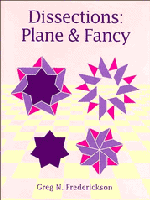Book contents
- Frontmatter
- Contents
- Preface
- 1 “Dat Pussle”
- 2 Our Geometric Universe
- 3 Fearful Symmetry
- 4 It's Hip to Be a Square
- 5 Triangles and Friends
- 6 All Polygons Created Equal
- 7 First Steps
- 8 Step Right Up!
- 9 Watch Your Step!
- 10 Just Tessellating
- 11 Plain Out-Stripped
- 12 Strips Teased
- 13 Tessellations Completed
- 14 Maltese Crosses
- 15 Curves Ahead
- 16 Stardom
- 17 Farewell, My Lindgren
- 18 The New Breed
- 19 When Polygons Aren't Regular
- 20 On to Solids
- 21 Cubes Rationalized
- 22 Prisms Reformed
- 23 Cheated, Bamboozled, and Hornswoggled
- 24 Solutions to All Our Problems
- Afterword
- Bibliography
- Index of Dissections
- General Index
11 - Plain Out-Stripped
Published online by Cambridge University Press: 05 August 2012
- Frontmatter
- Contents
- Preface
- 1 “Dat Pussle”
- 2 Our Geometric Universe
- 3 Fearful Symmetry
- 4 It's Hip to Be a Square
- 5 Triangles and Friends
- 6 All Polygons Created Equal
- 7 First Steps
- 8 Step Right Up!
- 9 Watch Your Step!
- 10 Just Tessellating
- 11 Plain Out-Stripped
- 12 Strips Teased
- 13 Tessellations Completed
- 14 Maltese Crosses
- 15 Curves Ahead
- 16 Stardom
- 17 Farewell, My Lindgren
- 18 The New Breed
- 19 When Polygons Aren't Regular
- 20 On to Solids
- 21 Cubes Rationalized
- 22 Prisms Reformed
- 23 Cheated, Bamboozled, and Hornswoggled
- 24 Solutions to All Our Problems
- Afterword
- Bibliography
- Index of Dissections
- General Index
Summary
Sacrebleu! These academicians hold our lives hostage in their footnotes! First, I demonstrate to this Professeur Catalan my method by which a square can be decomposed into seven pieces that form three equal squares. He labels it “empirique” in a footnote in his book. Next I extend my method, decomposing a square into a hexagone régulier in five pieces, and into a pentagone régulier in seven pieces. What does he do but suppress the constructions from my manuscript, giving as his excuse (where else but in a footnote!) “a lack of space.” Finally he attaches footnote after footnote to the paper on my problem by that “Génie” M. deCoatpont. No doubt this docteur, this professeur, this membre des sociétés and associé des académies, will be the cause of my death, which he will announce, naturellement, in a footnote.
The preceding bit of fabricated exasperation, which we assign to the Belgian Paul Busschop, underscores the lack of hoopla that accompanied his introduction of a new dissection technique in the 1870s. His first dissection was labeled as empirical by Eugène Catalan (1873), although Catalan (1879) no longer retained this characterization. In his role as journal editor, Catalan removed all but the claims of two more dissections in (Busschop 1876), due to lack of space. (However Catalan was kind enough to supply Busschop's full manuscript to Édouard Lucas, who included the dissections in (Lucas 1883).)
- Type
- Chapter
- Information
- DissectionsPlane and Fancy, pp. 117 - 135Publisher: Cambridge University PressPrint publication year: 1997



